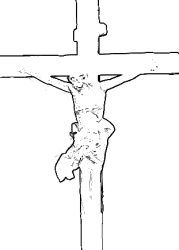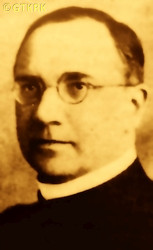Roman Catholic
St Sigismund parish
05-507 Słomczyn
85 Wiślana Str.
Konstancin deanery
Warsaw archdiocese, Poland
full list:
displayClick to display full list

searchClick to search full list by categories
wyświetlKliknij by wyświetlić pełną listę po polsku

szukajKliknij by przeszukać listę wg kategorii po polsku

Martyrology of the clergy — Poland
XX century (1914 – 1989)
personal data
surname
DUBOWY
forename(s)
Alexander Leo Ernest (pl. Aleksander Leon Ernest)

function
diocesan priest
creed
Latin (Roman Catholic) Church RCmore on
en.wikipedia.org
[access: 2014.09.21]
diocese / province
Wrocław archdiocesemore on
en.wikipedia.org
[access: 2013.05.19]
Berlin diocesemore on
en.wikipedia.org
[access: 2013.12.04]
Warmia diocesemore on
en.wikipedia.org
[access: 2018.09.02]
Wrocław diocesemore on
en.wikipedia.org
[access: 2013.05.19]
academic distinctions
Doctor of Theology
Doctor of Philosophy
nationality
Polish? German?
date and place
of death
26.02.1945

Kietrztoday: Kietrz gm., Głubczyce pov., Opole voiv., Poland
more on
en.wikipedia.org
[access: 2021.04.02]
details of death
During Russian winter offensive of 1945 that led to the end of military conflict of the World War II, started by German and Russian invasion of Poland in 09.1939, his Kietrz parish was captured by the Russians at the end of 03.1945.
Till then, from 01.1945 the German–Russian front line was c. 10 km to the north–east (c. 5 km north from a larger city, nearby Racibórz).
Perished in this, couple of months lasting lull in Russian advance, in unknown circumstances, prob. shot by Russian soldiers.
cause of death
murder
perpetrators
Russians (?)
sites and events
Ribbentrop‐MolotovClick to display the description, Pius XI's encyclicalsClick to display the description
date and place
of birth
15.08.1891

Dolní Benešovform.: Benešov u Hlučína
today: Hlučín r. mun., Opava dist., Moravian‐Silesian reg., Czechia
more on
en.wikipedia.org
[access: 2022.02.15]
alt. dates and places
of birth
Závadatoday: Hlučín r. mun., Opava dist., Moravian‐Silesian reg., Czechia
more on
en.wikipedia.org
[access: 2021.08.12]
presbyter (holy orders)
ordination
18.06.1914

Wrocławtoday: Wrocław city pov., Lower Silesia voiv., Poland
more on
en.wikipedia.org
[access: 2021.04.02]
St John the Baptist RC archcathedral churchmore on
pl.wikipedia.org
[access: 2021.12.19]
positions held
till 1945
resident — Třebomtoday: Kravaře r. mun., Opava dist., Moravian‐Silesian reg., Czechia
more on
en.wikipedia.org
[access: 2024.03.15]
from 1941
chaplain — Białaalso: Biała Prudnicka
today: Biała gm., Prudnik pov., Opole voiv., Poland
more on
en.wikipedia.org
[access: 2022.01.12] ⋄ School Sisters of Notre Dame SSND ⋄ RC parish ⋄ Białaalso: Biała Prudnicka
today: Biała gm., Prudnik pov., Opole voiv., Poland
more on
en.wikipedia.org
[access: 2022.01.12] RC deanery
c. 1939 – c. 1941
resident — Berlintoday: Berlin state, Germany
more on
en.wikipedia.org
[access: 2020.07.31] — in Berlin‐Friedrichshain and Berlin‐Kreuzberg
c. 1937 – c. 1938
resident — Waldfischbachtoday: Waldfischbach‐Burgalben, Südwestpfalz dist., Rhineland‐Palatinate state, Germany
more on
en.wikipedia.org
[access: 2024.03.15] ⋄ „Maria Rosenberg” retreat house
c. 1934 – c. 1936
resident — Berlintoday: Berlin state, Germany
more on
en.wikipedia.org
[access: 2020.07.31] — i.a. in Berlin–Weißensee; also: head of the Catholic association Germ. „Deutscher Katecheten–Verein” (Eng. „German Catechetical Association”)
1931 – 1933
rector — Braniewotoday: Braniewo urban gm., Braniewo pov., Warmia‐Masuria voiv., Poland
more on
en.wikipedia.org
[access: 2022.02.14] ⋄ Theological Seminary — lecturer in pastoral theology and homiletics; also: Germ. Honorarprofessor (Eng. titular professor) of pastoral theology in Germ. Staatliche Akademie Lyceum Hosianum (Eng. State Academy – Lyceum Hosianum)
c. 1927 – 1931
vicar — Wrocławtoday: Wrocław city pov., Lower Silesia voiv., Poland
more on
en.wikipedia.org
[access: 2021.04.02] ⋄ St John the Baptist RC archcathedral church — deputy cathedral cantor
c. 1927 – 1931
director — Wrocławtoday: Wrocław city pov., Lower Silesia voiv., Poland
more on
en.wikipedia.org
[access: 2021.04.02] ⋄ secretariat, spiritual retreats deparment, Archdiocesan Curia
c. 1926 – 1931
representative — Wrocławtoday: Wrocław city pov., Lower Silesia voiv., Poland
more on
en.wikipedia.org
[access: 2021.04.02] ⋄ German Union of Catechists ⋄ Wrocław RC archdiocese
1921 – 1927
vicar — Wrocławtoday: Wrocław city pov., Lower Silesia voiv., Poland
more on
en.wikipedia.org
[access: 2021.04.02] ⋄ St John the Baptist RC archcathedral church
1920 – 1921
chaplain — Wrocławtoday: Wrocław city pov., Lower Silesia voiv., Poland
more on
en.wikipedia.org
[access: 2021.04.02] ⋄ St Joseph hospital, St Elizabeth Sisters CSSE ⋄ St John the Baptist RC archcathedral parish
1916 – c. 1919
vicar — Berlintoday: Berlin state, Germany
more on
en.wikipedia.org
[access: 2020.07.31] ⋄ Holy Family RC parish ⋄ Berlintoday: Berlin state, Germany
more on
en.wikipedia.org
[access: 2020.07.31] RC deanery
1915 – 1916
prefect — Wrocławtoday: Wrocław city pov., Lower Silesia voiv., Poland
more on
en.wikipedia.org
[access: 2021.04.02] ⋄ Catholic St Matthew Gymnasium
1914 – 1916
lecturer — Wrocławtoday: Wrocław city pov., Lower Silesia voiv., Poland
more on
en.wikipedia.org
[access: 2021.04.02] ⋄ Theological Seminary
till 1914
PhD student — Wrocławtoday: Wrocław city pov., Lower Silesia voiv., Poland
more on
en.wikipedia.org
[access: 2021.04.02] ⋄ philosophy, Department of Catholic Theology, University of Wrocław [i.e. University of Wrocław (since 1945) / Frederic Wilhelm University of Silesia (1911‐1945) / Royal University i.e. Breslau Academy (1816‐1911)] — PhD thesis Germ. „Der Einfluß der apokryphen Petrus– und Paulusliteratur auf altchristliche Darstellungen der Apostelfürsten” (Eng. „The influence of the apocryphal literature on Peter and Paul on early Christian depictions of the princes of the apostles”), public defense in 09.06.1914
till 1914
PhD student — Wrocławtoday: Wrocław city pov., Lower Silesia voiv., Poland
more on
en.wikipedia.org
[access: 2021.04.02] ⋄ theology, Department of Catholic Theology, University of Wrocław [i.e. University of Wrocław (since 1945) / Frederic Wilhelm University of Silesia (1911‐1945) / Royal University i.e. Breslau Academy (1816‐1911)] — PhD thesis Germ. „Klemens von Rom über die Reise Pauli nach Spanien” (Eng. „Clement of Rome on Paul's journey to Spain”), public defense in 1914, published Freiburg im Breisgau 1914
from 1910
student — Wrocławtoday: Wrocław city pov., Lower Silesia voiv., Poland
more on
en.wikipedia.org
[access: 2021.04.02] ⋄ philosophy and theology, Theological Seminary
author of many publications in the field of pastoral theology, publisher of the magazines: Germ. „Homiletische Zeitfragen” (Eng. „Contemporary homiletical issues”), Germ. „Pastoraltheologische Zeitfragen” (Eng. „Contemporary pastoral issues”), Germ. „Religionspadagogische Zeitfragen” (Eng. „Contemporary issues of religious education”) , Germ.: „Ostdeutsches Pastoralblatt” (Eng. „East German pastoral journal”)
sites and events
descriptions
Ribbentrop‐Molotov: Genocidal Russian‐German alliance pact between Russian leader Joseph Stalin and German leader Adolf Hitler signed on 23.08.1939 in Moscow by respective foreign ministers, Mr. Vyacheslav Molotov for Russia and Joachim von Ribbentrop for Germany. The pact sanctioned and was the direct cause of joint Russian and German invasion of Poland and the outbreak of the World War II in 09.1939. In a political sense, the pact was an attempt to restore the status quo ante before 1914, with one exception, namely the „commercial” exchange of the so‐called „Kingdom of Poland”, which in 1914 was part of the Russian Empire, fore Eastern Galicia (today's western Ukraine), in 1914 belonging to the Austro‐Hungarian Empire. Galicia, including Lviv, was to be taken over by the Russians, the „Kingdom of Poland” — under the name of the General Governorate — Germany. The resultant „war was one of the greatest calamities and dramas of humanity in history, for two atheistic and anti‐Christian ideologies — national and international socialism — rejected God and His fifth Decalogue commandment: Thou shall not kill!” (Abp Stanislav Gądecki, 01.09.2019). The decisions taken — backed up by the betrayal of the formal allies of Poland, France and Germany, which on 12.09.1939, at a joint conference in Abbeville, decided not to provide aid to attacked Poland and not to take military action against Germany (a clear breach of treaty obligations with Poland) — were on 28.09.1939 slightly altered and made more precise when a treaty on „German‐Russian boundaries and friendship” was agreed by the same murderous signatories. One of its findings was establishment of spheres of influence in Central and Eastern Europe and in consequence IV partition of Poland. In one of its secret annexes agreed, that: „the Signatories will not tolerate on its respective territories any Polish propaganda that affects the territory of the other Side. On their respective territories they will suppress all such propaganda and inform each other of the measures taken to accomplish it”. The agreements resulted in a series of meeting between two genocidal organization representing both sides — German Gestapo and Russian NKVD when coordination of efforts to exterminate Polish intelligentsia and Polish leading classes (in Germany called «Intelligenzaktion», in Russia took the form of Katyń massacres) where discussed. Resulted in deaths of hundreds of thousands of Polish intelligentsia, including thousands of priests presented here, and tens of millions of ordinary people,. The results of this Russian‐German pact lasted till 1989 and are still in evidence even today. (more on: en.wikipedia.orgClick to attempt to display webpage
[access: 2015.09.30])
Pius XI's encyclicals: Facing the creation of two totalitarian systems in Europe, which seemed to compete with each other, though there were more similarities than contradictions between them, Pope Pius XI issued in 03.1937 (within 5 days) two encyclicals. In the „Mit brennender Sorge” (Eng. „With Burning Concern”) published on 14.03.1938, condemned the national socialism prevailing in Germany. The Pope wrote: „Whoever, following the old Germanic‐pre‐Christian beliefs, puts various impersonal fate in the place of a personal God, denies the wisdom of God and Providence […], whoever exalts earthly values: race or nation, or state, or state system, representatives of state power or other fundamental values of human society, […] and makes them the highest standard of all values, including religious ones, and idolizes them, this one […] is far from true faith in God and from a worldview corresponding to such faith”. On 19.03.1937, published „Divini Redemptoris” (Eng. „Divine Redeemer”), in which criticized Russian communism, dialectical materialism and the class struggle theory. The Pope wrote: „Communism deprives man of freedom, and therefore the spiritual basis of all life norms. It deprives the human person of all his dignity and any moral support with which he could resist the onslaught of blind passions […] This is the new gospel that Bolshevik and godless communism preaches as a message of salvation and redemption of humanity”… Pius XI demanded that the established human law be subjected to the natural law of God , recommended the implementation of the ideal of a Christian state and society, and called on Catholics to resist. Two years later, National Socialist Germany and Communist Russia came together and started World War II. (more on: www.vatican.vaClick to attempt to display webpage
[access: 2023.05.28], www.vatican.vaClick to attempt to display webpage
[access: 2023.05.28])
sources
personal:
www.litdok.deClick to attempt to display webpage
[access: 2015.09.30], studylib.esClick to attempt to display webpage
[access: 2019.02.02], pl.wikipedia.orgClick to attempt to display webpage
[access: 2024.03.15]
bibliographical:
„Opole Silesia clergy's martyrology during II World War”, Fr Andrew Hanich, Opole 2009
original images:
commons.wikimedia.orgClick to attempt to display webpage
[access: 2024.03.15]
LETTER to CUSTODIAN/ADMINISTRATOR
If you have an Email client on your communicator/computer — such as Mozilla Thunderbird, Windows Mail or Microsoft Outlook, described at WikipediaPatrz:
en.wikipedia.org, among others — try the link below, please:
LETTER to CUSTODIAN/ADMINISTRATORClick and try to call your own Email client
If however you do not run such a client or the above link is not active please send an email to the Custodian/Administrator using your account — in your customary email/correspondence engine — at the following address:

giving the following as the subject:
MARTYROLOGY: DUBOWY Alexander Leo Ernest
To return to the biography press below:
 Click to return to biography
Click to return to biography








